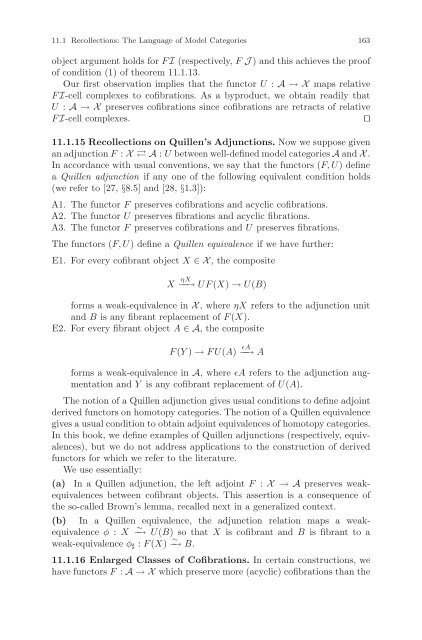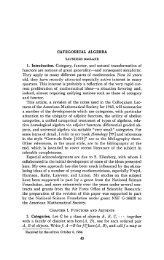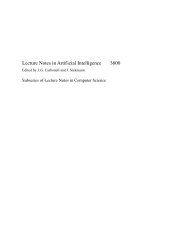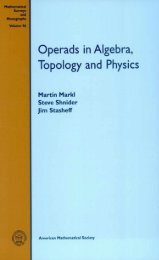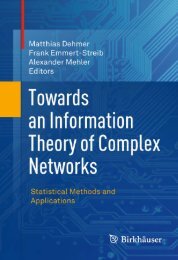Symmetric Monoidal Categories for Operads - Index of
Symmetric Monoidal Categories for Operads - Index of
Symmetric Monoidal Categories for Operads - Index of
Create successful ePaper yourself
Turn your PDF publications into a flip-book with our unique Google optimized e-Paper software.
11.1 Recollections: The Language <strong>of</strong> Model <strong>Categories</strong> 163<br />
object argument holds <strong>for</strong> F I (respectively, F J ) and this achieves the pro<strong>of</strong><br />
<strong>of</strong> condition (1) <strong>of</strong> theorem 11.1.13.<br />
Our first observation implies that the functor U : A→X maps relative<br />
F I-cell complexes to c<strong>of</strong>ibrations. As a byproduct, we obtain readily that<br />
U : A→X preserves c<strong>of</strong>ibrations since c<strong>of</strong>ibrations are retracts <strong>of</strong> relative<br />
F I-cell complexes. ⊓⊔<br />
11.1.15 Recollections on Quillen’s Adjunctions. Nowwesupposegiven<br />
an adjunction F : X ⇄ A : U between well-defined model categories A and X .<br />
In accordance with usual conventions, we say that the functors (F, U) define<br />
a Quillen adjunction if any one <strong>of</strong> the following equivalent condition holds<br />
(we refer to [27, §8.5] and [28, §1.3]):<br />
A1. The functor F preserves c<strong>of</strong>ibrations and acyclic c<strong>of</strong>ibrations.<br />
A2. The functor U preserves fibrations and acyclic fibrations.<br />
A3. The functor F preserves c<strong>of</strong>ibrations and U preserves fibrations.<br />
The functors (F, U) define a Quillen equivalence if we have further:<br />
E1. For every c<strong>of</strong>ibrant object X ∈X,thecomposite<br />
X ηX<br />
−−→ UF(X) → U(B)<br />
<strong>for</strong>ms a weak-equivalence in X ,whereηX refers to the adjunction unit<br />
and B is any fibrant replacement <strong>of</strong> F (X).<br />
E2. For every fibrant object A ∈A,thecomposite<br />
F (Y ) → FU(A) ɛA<br />
−→ A<br />
<strong>for</strong>ms a weak-equivalence in A, whereɛA refers to the adjunction augmentation<br />
and Y is any c<strong>of</strong>ibrant replacement <strong>of</strong> U(A).<br />
The notion <strong>of</strong> a Quillen adjunction gives usual conditions to define adjoint<br />
derived functors on homotopy categories. The notion <strong>of</strong> a Quillen equivalence<br />
gives a usual condition to obtain adjoint equivalences <strong>of</strong> homotopy categories.<br />
In this book, we define examples <strong>of</strong> Quillen adjunctions (respectively, equivalences),<br />
but we do not address applications to the construction <strong>of</strong> derived<br />
functors <strong>for</strong> which we refer to the literature.<br />
We use essentially:<br />
(a) In a Quillen adjunction, the left adjoint F : X → A preserves weakequivalences<br />
between c<strong>of</strong>ibrant objects. This assertion is a consequence <strong>of</strong><br />
the so-called Brown’s lemma, recalled next in a generalized context.<br />
(b) In a Quillen equivalence, the adjunction relation maps a weakequivalence<br />
φ : X ∼ −→ U(B) sothatX is c<strong>of</strong>ibrant and B is fibrant to a<br />
weak-equivalence φ♯ : F (X) ∼ −→ B.<br />
11.1.16 Enlarged Classes <strong>of</strong> C<strong>of</strong>ibrations. In certain constructions, we<br />
have functors F : A→X which preserve more (acyclic) c<strong>of</strong>ibrations than the


